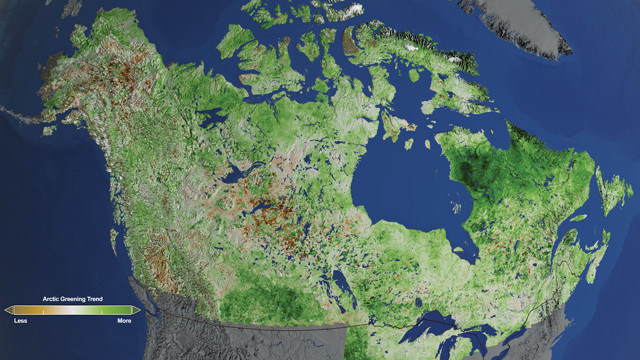
by Timothy Oleson Tuesday, July 26, 2016

Landsat data collected between 1984 and 2012 show that much of Canada and Alaska is greening as vegetation expands. Credit: NASA Goddard Space Flight Center/Cindy Starr.
From Antarctica to the Arctic; from polar caps, permafrost and glaciers to ocean-rafted sea ice; and from burly bears to cold-loving microbes, fascinating science is found in every nook and crevasse of Earth’s cryosphere, and new findings are announced often. Here are a few of the latest updates.
Much of the North American Arctic is getting greener, according to a new study analyzing 29 years of data from Landsats 5 and 7. Junchang Ju and Jeffrey Masek of NASA’s Goddard Space Flight Center in Greenbelt, Md., reported in the journal Remote Sensing of Environment that 29.4 percent of the land surface surveyed, which covered most of Canada and Alaska, showed statistically significant greening between 1984 and 2012. The trend was especially pronounced in western Alaska and across the northern coast of Canada into Quebec, where grasses and shrubs have expanded, presumably in part due to warming temperatures and longer growing seasons. Meanwhile, just 2.9 percent of the study area showed a decline, or browning, in vegetation. Researchers have looked at vegetation trends over Canada before using satellites, although the Landsat data in the new study offered far better resolution. In some cases, Ju and Masek noted, the trend in vegetation differed across small, adjacent areas. “It’s very localized,” Ju said in a statement. “The vegetation is responding to the microclimates. That’s the benefit of using Landsat data … we can reveal this spatial variation over very short distances.”
As global temperatures warm, more snowfall over Antarctica — because warmer air holds more moisture than cooler air — is supposed to mitigate, to an extent, the continent’s contribution to sea-level rise caused by increased melting of the ice sheet. At least, that’s been the conclusion from some climate models. But researchers studying the 3.4-kilometer-long West Antarctic Ice Sheet Divide ice core, drilled between 2006 and 2011, have challenged that assumption in a new study published in Geophysical Research Letters. They looked at the correlation between temperature and ice accumulation in West Antarctica recorded in the core over the last 31,000 years and found “that warmer temperatures and snowfall sometimes go together, but often they don’t,” said lead author T.J. Fudge of the University of Washington, in a statement. For example, a correlation between temperature and accumulation is seen from 8,000 years ago until the present, but from 15,000 to 8,000 years ago, there is no correlation. There also seems to be less correlation over shorter timescales, as in the past several decades, the team noted, indicating that atmospheric circulation and storm conditions likely play substantial roles in determining snowfall and ice accumulation. Overall, the results suggest that air temperature is a poor predictor of accumulation.
Some of Greenland’s 240 marine-terminating glaciers discharge ice into the sea significantly faster than others, an observation that scientists have not been able to fully explain. In a new study, researchers suggest that the depth of the seafloor where the glaciers flow into the water may be a big factor. Combining multibeam bathymetry collected between 2007 and 2014 from 14 glacial fjords along the coast of western Greenland, researchers led by Eric Rignot of the University of California at Irvine reported in Geophysical Research Letters that the seafloor beneath these fjords, which hadn’t been mapped in detail, was 100 to 1,000 meters deeper in many areas — and that seafloor depth was far more variable overall — than presumed. In some fjords, glaciers sit in water deeper than 1,000 meters, while in others they’re grounded on relatively shallow sills less than 200 meters deep. This matters because, around Greenland, seawater temperatures vary with depth, with colder surface waters chilled by Arctic runoff and deeper waters, below about 250 meters, warmed to 2.5 degrees Celsius or more above freezing by tropical Atlantic inflows. These varying depths could explain differences in glacial ice discharge, with deeper glaciers more subject to melting from below.
© 2008-2021. All rights reserved. Any copying, redistribution or retransmission of any of the contents of this service without the expressed written permission of the American Geosciences Institute is expressly prohibited. Click here for all copyright requests.